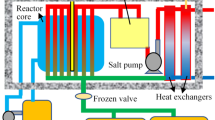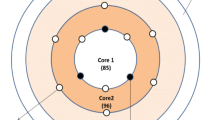Abstract
The possibility of utilizing thorium as a fuel in a pressurized water reactor (PWR) has been proven from the neutronic perspective in our previously published work without assessing the thermal hydraulic (TH) and solid structure performances. Therefore, the TH and solid structure performances must be studied to confirm these results and ensure the possibility of using a thorium-based fuel as an excellent accident-tolerant fuel. The TH and solid structure performances of thorium-based fuels were investigated and compared with those of UO2. The radial and axial power peaking factors (PPFs) for UO2, (232Th, 235U) O2, and (232Th, 233U) O2 were examined with a PWR assembly to determine the total PPF of each one. Both Gd2O3 and Er2O3 were tested as burnable absorbers (BAs) to manage the excess reactivity at the beginning of the fuel cycle (BOC) and reduce the total PPF. Er2O3 resulted in a more significant reduction to the total PPF and, therefore, a greater reduction to the temperature distribution compared to Gd2O3. Given these results, we analyzed the effects of adding Er2O3 to thorium-based fuels on their TH and solid structure performances.













Similar content being viewed by others
References
L.G.G. Fonseca, M. Hedberg, L. Huan et al., Application of SPS in the fabrication of UN and (U, Th)N pellets from microspheres. J. Nucl. Mater. 536, 152181 (2020). https://doi.org/10.1016/j.jnucmat.2020.152181
M.Y.M. Mohsen, M.A.E. Abdel-Rahman, A.A. Galahom, Integrated analysis of VVER-1000 fuel assembly fueled with accident tolerant fuel (ATF) materials. Ann. Nucl. Energy 159, 108330 (2021). https://doi.org/10.1016/j.anucene.2021.108330
A.A. Galahom, M.Y.M. Mohsen, N. Amrani, Explore the possible advantages of using thorium-based fuel in a pressurized water reactor (PWR) part 1: neutronic analysis. Nucl. Eng. Technol. (2021). https://doi.org/10.1016/j.net.2021.07.019
F. Faghihi, S.M. Mirvakili, Burn up calculations for the Iranian miniature reactor: a reliable and safe research reactor. Nucl. Eng. Des. 239, 1000–1009 (2009). https://doi.org/10.1016/j.nucengdes.2009.01.014
Y. Lu, Y. Yang, P. Zhang, Thermodynamic properties and structural stability of thorium dioxide. J. Phys. Condens. Matter 24, 225801 (2012). https://doi.org/10.1088/0953-8984/24/22/225801
H. Muta, Y. Murakami, M. Uno et al., Thermophysical properties of Th1−xUxO2 pellets prepared by spark plasma sintering technique. J. Nucl. Sci. Technol. 50, 181–187 (2013). https://doi.org/10.1080/00223131.2013.757468
A.A. Galahom, Minimization of the fission product waste by using thorium based fuel instead of uranium dioxide. Nucl. Eng. Des. 314, 165–172 (2017). https://doi.org/10.1016/j.nucengdes.2017.01.024
E.H. Ugurua, S.F. Abdulsani, M.U. Khandaker et al., Investigation on the effect of 238U replacement with 232Th in small modular reactor (SMR) fuel matrix. Prog. Nucl. Energy 118, 103108 (2020). https://doi.org/10.1016/j.pnucene.2019.103108
S.M. Mirvakili, Z. Gholamzadeh, S.A.H. Feghhi, Computational analysis of neutronic effects of ThO2 rods loaded in CANDU 6 fuel assemblies. Nucl. Sci. Tech. 27, 79 (2016). https://doi.org/10.1007/s41365-016-0101-y
J. Al Zain, O. El Hajjaji, T. El Bardouni et al., Neutronic and burn-up calculations of the (ThO2–UO2) pin cell benchmark using DRAGON5 and MCNP6.2 codes with ENDF/B-VIII.0 nuclear data library. Int. J. Energy Res. 45, 11538–11551 (2021). https://doi.org/10.1002/er.6460
X. Zhao, D. Cui, X. Cai et al., Analysis of Th-U breeding capability for an accelerator-driven subcritical molten salt reactor. Nucl. Sci. Tech. 29, 121 (2018). https://doi.org/10.1007/s41365-018-0448-3
D.P. Daroca, S. Jaroszewicz, A.M. Llois et al., Phonon spectrum, mechanical and thermophysical properties of thorium carbide. J. Nucl. Mater. 437, 135–138 (2013). https://doi.org/10.1016/j.jnucmat.2013.01.350
A.E. Shields, D. Santos-Carballal, N.H. de Leeuw, A density functional theory study of uranium-doped thoria and uranium adatoms on the major surfaces of thorium dioxide. J. Nucl. Mater. 473, 99–111 (2016). https://doi.org/10.1016/j.jnucmat.2016.02.009
A.E. Shields, S.E.R. Hernandez, N.H. de Leeuw, Theoretical analysis of uranium-doped thorium dioxide: introduction of a thoria force field with explicit polarization. AIP Adv. 5, 087118 (2015). https://doi.org/10.1063/1.4928438
G. McKinney, MCNPX User’s Manual. Version 2 (7) (2011)
A.A. Galahom, Improving the neutronic characteristics of a boiling water reactor by using uranium zirconium hydride fuel instead of uranium dioxide fuel. Nucl. Eng. Technol. 48, 751–757 (2020). https://doi.org/10.1016/j.net.2016.01.003
N.E. Todreas, M.S. Kazimi, Nuclear Systems I: Thermal Hydraulic Fundamentals (Hemisphere Publishing Co., New York, 1990). ISBN: 0891169350
M.Y.M. Mohsen, M.S. Hassan, M. Aziz et al., Investigating the neutronic, thermal-hydraulic, and solid mechanics analysis for AP-1000 nuclear reactor. Energy Sources Part A Recovery Util. Environ. Eff. 1, 5 (2021). https://doi.org/10.1080/15567036.2021.1912215
IAEA, Thermophysical Properties of Materials for Nuclear Engineering: A Tutorial and Collection of Data (Vienna, 2009)
V. Haase, H. Keller-Rudek, L. Manes et al., U Uranium-Supplement Volume C5 Uranium Dioxide, UO2, Physical Properties (Springer, Berlin, 1986). https://doi.org/10.1007/978-3-662-10719-5
K. Geelhood, W.G. Luscher, Material Property Correlations: Comparisons Between FRAPCON-4.0, FRAPTRAN-2.0, and MATPRO (2015). https://doi.org/10.2172/1030897
A.K. Sengupta, T. Jarvis, M.R. Nair et al., Thermal Diffusivity and Thermal Conductivity of (Th, U)O FUELS. INDIA (2000). https://doi.org/10.1016/j.jnucmat.2018.01.014
F. Faghihi, S.M. Mirvakili, S.S. Arshi et al., Neutronics and sub-channel thermal-hydraulics analysis of the Iranian VVER-1000 fuel bundle. Prog. Nucl. Energy 87, 39–46 (2016). https://doi.org/10.1016/j.pnucene.2015.10.020
A.A. Galahom, Investigation of different burnable absorbers effects on the neutronic characteristics of PWR assembly. Ann. Nucl. Energy 94, 22–31 (2016). https://doi.org/10.1016/j.anucene.2016.02.025
S. Peterson, R.E. Adams, D.A. Douglas Jr., Properties of Thorium, Its Alloys and Its Compounds (International Atomic Energy Agency (IAEA): IAEA, 1966)
R.A. Wolfe, S.F. Kaufman, Mechanical Properties of Oxide Fuels (LSBR/LWB DEVELOPMENT PROGRAM), United States 1967-01-01. https://www.osti.gov/biblio/4511674
Author information
Authors and Affiliations
Contributions
All authors contributed to the study conception and design. Material preparation, data collection, and analysis were performed by Mohamed Y.M. Mohsen, Mohamed A.E. Abdel-Rahman, and A. Abdelghafar Galahom. The first draft of the manuscript was written by Mohamed Y.M. Mohsen, and all authors commented on previous versions of the manuscript. All authors read and approved the final manuscript.
Corresponding author
Rights and permissions
About this article
Cite this article
Mohsen, M.Y.M., Abdel-Rahman, M.A.E. & Galahom, A.A. Ensuring the possibility of using thorium as a fuel in a pressurized water reactor (PWR). NUCL SCI TECH 32, 137 (2021). https://doi.org/10.1007/s41365-021-00981-0
Received:
Revised:
Accepted:
Published:
DOI: https://doi.org/10.1007/s41365-021-00981-0




